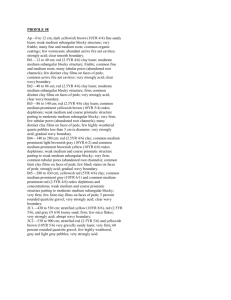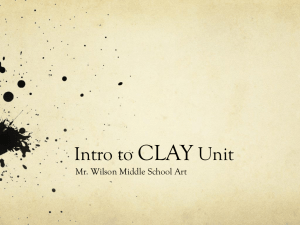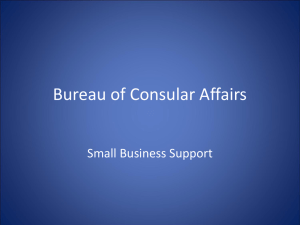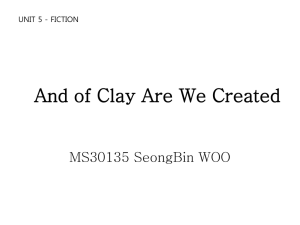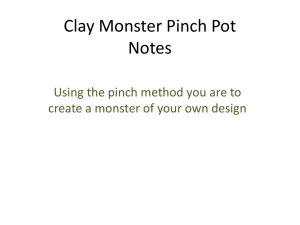Lab 2: Soil Properties and Profiles
advertisement
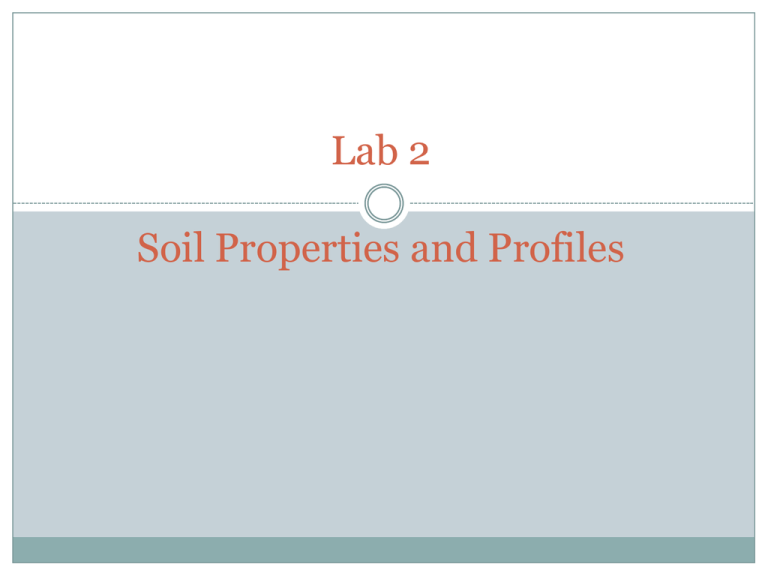
Lab 2 Soil Properties and Profiles Activities for Today Texture: Determine texutral classes by feel, and identify textures of unknown samples; Soil Color: Understand terminology of the Munsell color system (hue, value, chroma) and use it to determine soil color; Learn the nomenclature for master horizon suffixes, and transition horizons, and use them in labeling horizons on a monolith or soil profile description. Soil Texture Textural classes of soils are named on their predominant feel and correspond to percentages of sand, silt, and clay. Soil Texture Sandy textures- feel gritty Silty textures- feel smooth, soft, and floury Clay textures- stiff, waxy, and plastic How to Texture Golf-ball-sized amount of soil in your hand Soil needs to be moist but not wet(add water slowly) Knead the soil in your hand, between your thumb and fingers. Ribbon (?)/ Gritty, waxy, smooth How To Texture <1” (weak) ribbon; not stiff, waxy 1-2” (moderate) ribbon > 2” ribbon; v. stiff, waxy Very gritty SAND/ LOAMY SAND SANDY LOAM SANDY CLAY LOAM CLAY Intermediate gritty vs. smooth ------- LOAM CLAY LOAM CLAY -------- SILT LOAM SILTY CLAY LOAM CLAY Makes NO ribbon Very smooth; little grit Soil Color Dark brown to black- ( A horizon) top soils, humus- decomposed organic material. A few percent of humus gives a brownish color and up to 5% the soil becomes black. Soil Color Reds and Yellows- (B horizons) iron oxide formed during weathering, Fe+3 is well oxidized (well-drained) Soil Color Grey colors are caused by reduced Iron (Fe+2 ) Water has excluded oxygen from diffusion into soil Other pigments are leached out from horizons (humus, iron oxides) Soil Color Determination Hue- is the dominant spectral color of the entire page of chips. 10YR- all chips on the page are composed of 10 parts of yellow(Y) to 1 part red(R). Value – lightness or darkness of the color. 8- light color and 2 – dark color (high humus content) Chroma- brightness or dullness of a color chip. 1dull (grayish/waterlogged) and 8 bright (oxidation) Munsel Color Chart 10YR 5/3 Hue Value Chroma Soil Color Matrix color- main or background color Mottles – other colors within the matrix Redoximorphic features- reduction of Fe and oxidation of Fe. Grey Mottles Soil Structure Horizon Designations O Horizon: organic debris a – Highly decomposed litter e – intermediate , partially decomposed litter i - slightly decomposed, identifiable litter A Horizon: contains humus p – plowed, shown by sharp boundary with horizon below ( abrupt transition) b – buried, A-type horizon found buried in profile E horizon: light-colored, leached; NO suffixes Horizon Designations B Horizon: material moved INTO h- illuvial humus present t- clay inc. compared to A; clay films w- NO clay increase; blocky structure *g- gleyed(chroma ≤ 2) C Horizon: weathered parent material r- hard to dig; almost R *g – gleyed (chroma ≤ 2) “types” of B horizons: only 1 in each profile Horizon Designations Suffixes that are number are used to indicate different parts of the same horizon. Bt-Bt1, Bt2 Transition horizon- occurs between two master horizons that have the properties of both. “AE” transition layer is between A and E horizons, more like an A than an E. O: leaf litter at top either “a”, “e”, or “i” A: topsoil (humus) add “p” if abrupt E: same texture as A; often light color Transition horizons: either EB or BE B horizon either “t”, “w”, or “h”; add “”g” Transition (maybe) C horizon: add “g” or “r” if necessary R: cant dig it…. Soil Profile _ 0-1” _ _1”-6” 10YR 3/4 _ _6”-13” 10YR 6/3 _ 13”-25” 2.5YR 4/6 _ 25”-35” 5YR 5/6 _ _35”-47” _ _47+” hardwood leaves and twigs sandy loam granular sandy loam granular clay blocky clay loam blocky saprolite massive hard gneiss and schist Soil Profile Oi_ 0-1” _A_1”-6” 10YR 3/4 _E_6”-13” 10YR 6/3 _Bt 13”-25” 2.5YR 4/6 _BC 25”-35” 5YR 5/6 _C_35”-47” _R_47+” hardwood leaves and twigs sandy loam granular sandy loam granular clay blocky clay loam blocky saprolite massive hard gneiss and schist ___--0 to 8 inches; reddish brown (5YR 4/4) loam; moderate medium granular structure; friable; many fine roots; common fine pores; common fine black concretions; slightly acid, abrupt smooth boundary. (2 to 11 inches thick) ___--8 to 17 inches; yellowish red (5YR 4/6) clay; moderate medium subangular blocky structure; firm, sticky, plastic; common fine roots; few fine pores; many fine black concretions; common distinct clay films on faces of peds; slightly acid; gradual wavy boundary. ___--17 to 25 inches; yellowish red (5YR 4/8) clay; common fine distinct brownish yellow (10YR 6/6) mottles; moderate medium subangular blocky structure; firm, sticky, plastic; few fine roots; few fine pores; common black concretions; common distinct clay films on faces of peds; slightly acid; gradual wavy boundary. (Combined thickness of the Bt horizon is 12 to 35 inches.) ___--25 to 36 inches; yellowish red (5YR 4/8) clay loam; common medium faint reddish yellow (7.5YR 6/6) and common fine distinct yellowish brown (10YR 5/4) mottles; weak subangular blocky structure; firm, sticky, plastic; few fine black concretions; common fine lenses of gray clayey saprolite; slightly acid; gradual wavy boundary. (3 to 15 inches thick) ___--36 to 60 inches; mottled yellowish red (5YR 4/8), reddish yellow (7.5YR 6/6) and yellowish brown (10YR 5/4) highly weathered saprolite that has a sandy clay loam texture; massive; friable; many black and gray minerals; slightly acid ___--0 to 8 inches; reddish brown (5YR 4/4) loam; moderate medium granular structure; friable; many fine roots; common fine pores; common fine black concretions; slightly acid, abrupt smooth boundary. (2 to 11 inches thick) ___--8 to 17 inches; yellowish red (5YR 4/6) clay; moderate medium subangular blocky structure; firm, sticky, plastic; common fine roots; few fine pores; many fine black concretions; common distinct clay films on faces of peds; slightly acid; gradual wavy boundary. ___--17 to 25 inches; yellowish red (5YR 4/8) clay; common fine distinct brownish yellow (10YR 6/6) mottles; moderate medium subangular blocky structure; firm, sticky, plastic; few fine roots; few fine pores; common black concretions; common distinct clay films on faces of peds; slightly acid; gradual wavy boundary. (Combined thickness of the Bt horizon is 12 to 35 inches.) ___--25 to 36 inches; yellowish red (5YR 4/8) clay loam; common medium faint reddish yellow (7.5YR 6/6) and common fine distinct yellowish brown (10YR 5/4) mottles; weak subangular blocky structure; firm, sticky, plastic; few fine black concretions; common fine lenses of gray clayey saprolite; slightly acid; gradual wavy boundary. (3 to 15 inches thick) ___--36 to 60 inches; mottled yellowish red (5YR 4/8), reddish yellow (7.5YR 6/6) and yellowish brown (10YR 5/4) highly weathered saprolite that has a sandy clay loam texture; massive; friable; many black and gray minerals; slightly acid Ap--0 to 8 inches; reddish brown (5YR 4/4) loam; moderate medium granular structure; friable; many fine roots; common fine pores; common fine black concretions; slightly acid, abrupt smooth boundary. (2 to 11 inches thick) Bt1--8 to 17 inches; yellowish red (5YR 4/6) clay; moderate medium subangular blocky structure; firm, sticky, plastic; common fine roots; few fine pores; many fine black concretions; common distinct clay films on faces of peds; slightly acid; gradual wavy boundary. Bt2--17 to 25 inches; yellowish red (5YR 4/8) clay; common fine distinct brownish yellow (10YR 6/6) mottles; moderate medium subangular blocky structure; firm, sticky, plastic; few fine roots; few fine pores; common black concretions; common distinct clay films on faces of peds; slightly acid; gradual wavy boundary. (Combined thickness of the Bt horizon is 12 to 35 inches.) BC--25 to 36 inches; yellowish red (5YR 4/8) clay loam; common medium faint reddish yellow (7.5YR 6/6) and common fine distinct yellowish brown (10YR 5/4) mottles; weak subangular blocky structure; firm, sticky, plastic; few fine black concretions; common fine lenses of gray clayey saprolite; slightly acid; gradual wavy boundary. (3 to 15 inches thick) C--36 to 60 inches; mottled yellowish red (5YR 4/8), reddish yellow (7.5YR 6/6) and yellowish brown (10YR 5/4) highly weathered saprolite that has a sandy clay loam texture; massive; friable; many black and gray minerals; slightly acid
